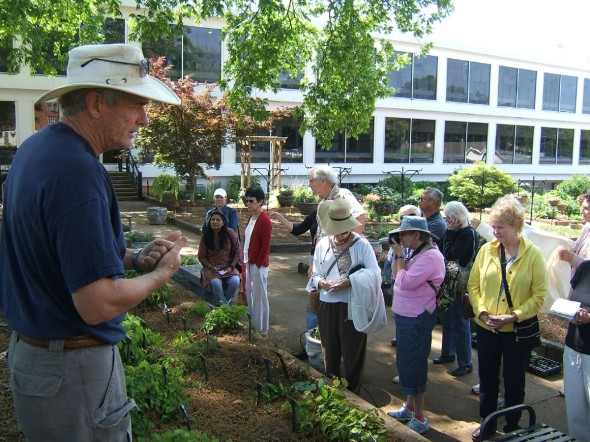UGA Trial Gardens and GA Botanical Gardens Field Trip – May 2011

As a new Intern, I decided to make the UGA Trial Gardens and Georgia Botanical Gardens my very first garden tour. Although I did not know what to expect, other than perhaps learning about some interesting plants, I eagerly anticipated the day. The group met at the Extension Office at 8:15am. I volunteered to drive, but when George Nash tried to fit his lanky frame into the back seat, we knew we had to resort to plan B. George offered to drive, so Jeannine Nash, Terry Russell and I navigated. Terry talked about her farm and menagerie, including rescued roosters. Jeannine and George explained how the Hydrangea festival started over 15 years ago when folks wanted to come see their hydrangeas. George and Jeannine decided to make it an official event and hence the birth of the Nash Hydrangea festival.
When we reached UGA, we were greeted by the friendly staff who gave us an overall description of the garden’s purpose. Shortly, Dr. Allan Armitage, dressed in his signature straw hat, began the more in-depth tour. He took us from flower to flower, plant to plant, explaining why it was in the garden. He often gave us a little story about a particular plant, such as the delicate Torenia fournieri, Wishbone Flower, and pointed out how its’ stamen was in the shape of a tiny wishbone and once you saw it, you would never forget. He asked if any of us attended the Plantapalooza and said the event made over $18,000. It was significant because budget cuts to the program required alternative means of funding. As we walked along, I was amazed at the knowledge of our Master Gardeners. I don’t think I will ever come close, but I am thankful they are so willing to share.

Around noon, we piled back into our cars and van and headed over to the Georgia Botanical Gardens, where we were greeted by two Master Gardeners, who would be our tour guides and two interns who would get answers to questions. Before the tour began, we all pulled out our brown bags, although most of us actually had coolers, and settled on the deck for lunch. The selection was wonderful because all of us shared bits of our lunch with each other. It seemed more like a smorgasbord than a brown bag. After lunch, we divided into two groups. The guide for our group was Peggy, who is from Hall County, but volunteered at the Botanical Gardens. As we walked, Peggy pointed out historical facts about the individual gardens. There were over 313 acres in total, with each garden having a theme. The funds were sometimes donated by organizations but more often, by individuals who wanted to share their love of nature with others. We started with the Egyptian Garden. Peggy explained the Egyptians surrounded their gardens with high walls to keep the desert sand from destroying them. She also explained that the tax rate for the Egyptian farmer was based upon the water level of the Nile. When she asked if any of us knew why and a few figured it out so I intend to let you, the reader, do the same. As we walked, she pointed out the different gardens, the American garden, English garden, the Heritage garden and told us about some of the interesting plant stories associated with the individual gardens, too many to document here. We were all beginning to tire, so the woodland gazebo was a welcome respite, shady, serene and so-o-o restful. As we headed back, we came to a ‘decision’ circle. We could go straight and by-pass some of the gardens and get back to the starting point or we could take the longer route and see more. As exhausted and hot as we all were, almost in unison, we said we wanted to continue, so our little “rag-tag team” forged forward taking in the remaining sites and smells of the Botanical Gardens. Once we got back inside, we had one more area to see. Fortunately, it was cool and shady. Peggy explained that all of the plants in this area had a purpose. This link will provide information about the plants in the conservatory. http://www.uga.edu/botgarden/garconservatory.html
Around 2:00pm, we got into our cars and headed back to the extension office, tired, but looking forward to our next garden tour.
Upon reflection, I realized that not only did I learn about the vast variety of trees, shrubs and flowers that inhabit our earth, but I also became more acutely aware of the friends we have made as our association with the Gwinnett County Master Gardeners continues to grow and blossom. More importantly, I realized that, like the plants, each of us has a vital part to play in this garden we call life.
